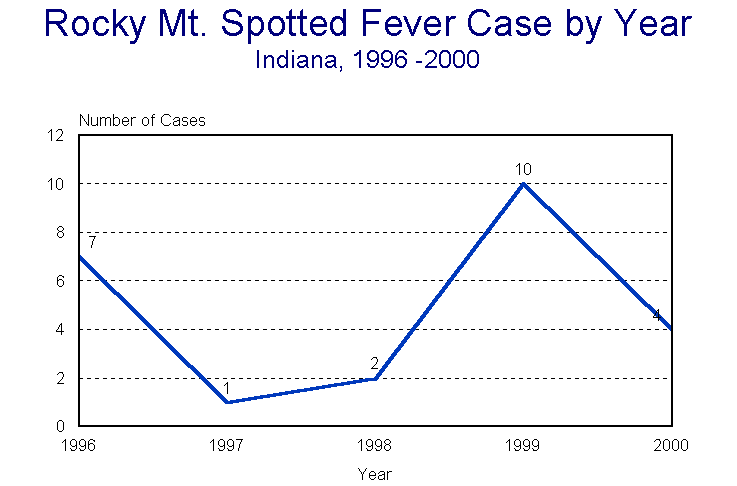Figure RM1: Rocky Mountain Spotted Fever Cases, Indiana, 1996-2000

2000 Indiana Report of Infectious Diseases |
View CDC's Rocky Mountain spotted fever page
Cases = 4
Rocky Mountain spotted fever (RMSF) occurs sporadically and infrequently in Indiana. From 1996-2000 the number of cases have ranged from a low of 1 to a high of 10, with a median of 4 cases/year. Figure RM1 presents the number of cases by year for 1996-2000. Figure RM2 shows the distribution of counties of residence where cases of RMSF have been reported for 1996-2000. While RMSF can occur across the state, case distribution has a tendency to regionalize in the very southern portion as seen in Figure RM2. It is important to note that county of residence may not reflect where the disease exposure occurred. Figure RM3 shows the number of reported cases by sex for 1996-2000. The female to male case ratio was 1:1.6. Reported cases ranged in age from 4 to 75 years, with a mean age of 29. The mean age for males was 28.3 and for females 30.1 years.
RMSF is caused by Rickettsia rickettsii. Transmitted by ticks, the principal vector is Dermacentor variabilis, which is the most common tick in Indiana. The disease is characterized by sudden onset with fever, malaise, deep muscle pain, severe headache, chills, and conjunctivitis. In approximately 50% of the cases, a maculopapular rash appears on the extremities before spreading to the palms and soles. The rash rapidly spreads to the body. Petechiae and hemorrhage are common. In the absence of specific therapy, mortality may be as high as 25%. With prompt recognition and antibiotic therapy, death is rare. Diagnosis is confirmed by serological testing of acute and convalescent specimens. Single specimens may be confirmatory if taken after the first two weeks of illness.
There is no vaccine available to prevent RMSF; therefore, prevention rests solely on avoidance of tick-infested areas or personal hygiene efforts. Individuals who enter tick-infested areas for recreation or occupational reasons should wear protective clothing (long-sleeved shirts and long pants), use repellents such as DEET, and check themselves thoroughly for ticks after leaving the tick habitat.
A report prepared by Dr. Robert Pinger of Ball State University describing in more detail the distribution of ticks that are vectors for RMSF can be found on the Ball State University web site at: http://web.bsu.edu/physiology/new_website/ento_lab_phel.asp.
Back to Top of Article
Back to Table of Contents
|
Figure RM1: Rocky Mountain Spotted Fever Cases, Indiana, 1996-2000 |
|
|
Back to Reference in Text
Back to Top of Article
|
Figure RM2: County of Residence, RMSF Cases, Indiana, 1996-2000 |
|
|
Back to Reference in Text
Back to Top of Article
|
Figure RM3: Rocky Mountain Spotted Fever Cases by Sex, Indiana, 1996-2000 |
|
|
Back to Reference in Text
Back to Top of Article
Back to Table of Contents
[an error occurred while processing this directive]